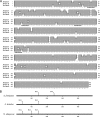Aspergillus section Fumigati typing by PCR-restriction fragment polymorphism
- PMID: 19403766
- PMCID: PMC2708504
- DOI: 10.1128/JCM.00551-09
Aspergillus section Fumigati typing by PCR-restriction fragment polymorphism
Abstract
Recent studies have shown that there are multiple clinically important members of the Aspergillus section Fumigati that are difficult to distinguish on the basis of morphological features (e.g., Aspergillus fumigatus, A. lentulus, and Neosartorya udagawae). Identification of these organisms may be clinically important, as some species vary in their susceptibilities to antifungal agents. In a prior study, we utilized multilocus sequence typing to describe A. lentulus as a species distinct from A. fumigatus. The sequence data show that the gene encoding beta-tubulin, benA, has high interspecies variability at intronic regions but is conserved among isolates of the same species. These data were used to develop a PCR-restriction fragment length polymorphism (PCR-RFLP) method that rapidly and accurately distinguishes A. fumigatus, A. lentulus, and N. udagawae, three major species within the section Fumigati that have previously been implicated in disease. Digestion of the benA amplicon with BccI generated unique banding patterns; the results were validated by screening a collection of clinical strains and by in silico analysis of the benA sequences of Aspergillus spp. deposited in the GenBank database. PCR-RFLP of benA is a simple method for the identification of clinically important, similar morphotypes of Aspergillus spp. within the section Fumigati.
Figures


Similar articles
-
Restriction analysis of an amplified rodA gene fragment to distinguish Aspergillus fumigatus var. ellipticus from Aspergillus fumigatus var. fumigatus.FEMS Microbiol Lett. 2012 Aug;333(2):153-9. doi: 10.1111/j.1574-6968.2012.02608.x. Epub 2012 Jun 18. FEMS Microbiol Lett. 2012. PMID: 22670589
-
Diversity and specificity of microsatellites within Aspergillus section Fumigati.BMC Microbiol. 2012 Jul 28;12:154. doi: 10.1186/1471-2180-12-154. BMC Microbiol. 2012. PMID: 22838495 Free PMC article.
-
Genetic variability within the Aspergillus viridinutans species.Folia Microbiol (Praha). 2000;45(5):423-8. doi: 10.1007/BF02817615. Folia Microbiol (Praha). 2000. PMID: 11347269
-
Aspergillus fumigatus-Related Species in Clinical Practice.Front Microbiol. 2016 May 17;7:683. doi: 10.3389/fmicb.2016.00683. eCollection 2016. Front Microbiol. 2016. PMID: 27242710 Free PMC article. Review.
-
Molecular typing of Aspergillus species.Mycoses. 2008 Nov;51(6):463-76. doi: 10.1111/j.1439-0507.2008.01538.x. Epub 2008 Sep 12. Mycoses. 2008. PMID: 18793268 Review.
Cited by
-
Anti-Aspergillus fumigatus IgG in patients with bronchiectasis and its relationship with clinical outcome.Arch Microbiol. 2022 Nov 24;204(12):728. doi: 10.1007/s00203-022-03345-3. Arch Microbiol. 2022. PMID: 36434134
-
Neosartorya udagawae (Aspergillus udagawae), an emerging agent of aspergillosis: how different is it from Aspergillus fumigatus?J Clin Microbiol. 2010 Jan;48(1):220-8. doi: 10.1128/JCM.01556-09. Epub 2009 Nov 4. J Clin Microbiol. 2010. PMID: 19889894 Free PMC article.
-
Discovery of a sexual cycle in Aspergillus lentulus, a close relative of A. fumigatus.Eukaryot Cell. 2013 Jul;12(7):962-9. doi: 10.1128/EC.00040-13. Epub 2013 May 6. Eukaryot Cell. 2013. PMID: 23650087 Free PMC article.
-
A Case Report on Aspergillus lentulus Pneumonia.Balkan Med J. 2013 Dec;30(4):429-31. doi: 10.5152/balkanmedj.2013.8572. Epub 2013 Dec 1. Balkan Med J. 2013. PMID: 25207153 Free PMC article.
-
Multicenter study of isavuconazole MIC distributions and epidemiological cutoff values for Aspergillus spp. for the CLSI M38-A2 broth microdilution method.Antimicrob Agents Chemother. 2013 Aug;57(8):3823-8. doi: 10.1128/AAC.00636-13. Epub 2013 May 28. Antimicrob Agents Chemother. 2013. PMID: 23716059 Free PMC article.
References
-
- Balajee, S. A., A. M. Borman, M. E. Brandt, J. Cano, M. Cuenca-Estrella, E. Dannaoui, J. Guarro, G. Haase, C. C. Kibbler, W. Meyer, K. O'Donnell, C. A. Petti, J. L. Rodriguez-Tudela, D. Sutton, A. Velegraki, and B. L. Wickes. 2009. Sequence-based identification of Aspergillus, Fusarium, and Mucorales species in the clinical mycology laboratory: where are we and where should we go from here? J. Clin. Microbiol. 47877-884. - PMC - PubMed
Publication types
MeSH terms
Substances
Grants and funding
LinkOut - more resources
Full Text Sources
Miscellaneous

